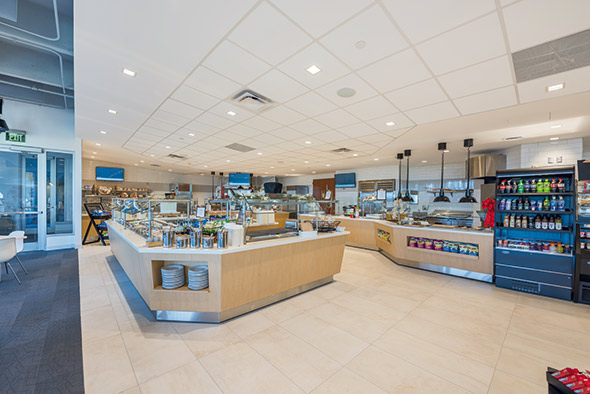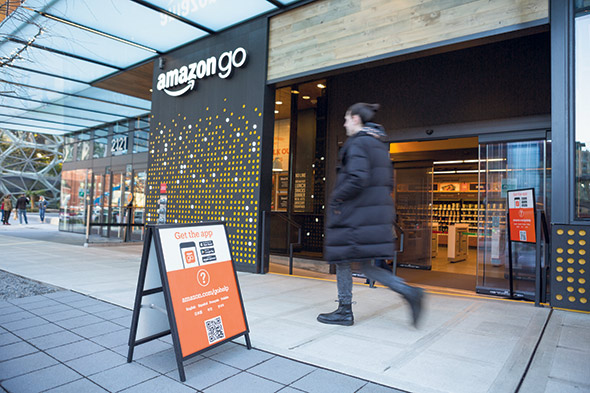Noncommercial operators find success integrating retail components.
It only makes sense that the noncommercial sector would take its share of the retail foodservice market. Often thought of as grab-and-go, retail represents a fast-growing component of foodservice, regardless of the segment. Healthcare, education and the business and industry (B&I) sector are all ripe with potential customers who are on the run or seeking eating options at odd hours.
“A lot of it has to do with the changing consumer and food culture,” says Tarah Schroeder, principal and director of sustainability at Ricca Design Studios in Denver. “Also, construction costs are up, labor is an issue and everyone is talking about convenience, which are all driving inclusion of retail into noncommercial spaces.”
Tech as Influencer
In the noncommercial space the current basic retail foodservice setup includes shelving, air stream coolers and refrigerated cases with doors, according to Kevin Banas, a project manager at foodservice consulting firm Cini-Little International, headquartered in Washington, D.C. “However, we are seeing shops where the grab-and-go area is in its own room with security cameras monitoring what’s being taken out and automatically debiting an account, like Amazon Go,” he adds.
The Amazon Go model showcases technology as a way to accommodate retail when there is a lack of space and/or manpower — the same issues that healthcare facilities, B&I feeders and other operators in the noncommercial space often face. This approach offers consumers a checkout-free shopping experience: The technology tracks items taken off shelves, places them in a virtual cart and then automatically charges each customer’s Amazon account upon departure.
 Amazon Go uses technology to enable fast transactions; it’s a checkout- free shopping experience.
Amazon Go uses technology to enable fast transactions; it’s a checkout- free shopping experience.
Similarly, technology now exists for shoppers to download a dedicated foodservice app and pick up items in temperature-controlled lockers. Eatsa used this approach with its kiosk-centric stores. (Eatsa closed shop last summer and relaunched in a new form as technology company Brightloom.) The kiosk-type model continues to have legs.
“For one of our larger B&I clients in California, we put in a retail component where employees can order what they want on their smartphone and the item is waiting in a numbered locker, which is either heated or cooled depending on the order requirements,” Banas says. “Shoppers use the app to unlock the locker.”
Other formats are also experimenting with how to capitalize on retail sales by incorporating the latest technology. “We just completed a retail space at Chicago’s Columbia College that uses the honor system, with a security camera and self-checkout register,” Banas says. “Students scan or type in their purchase and pay with their dining hall card.”
Expanding Hours and Options
Because people seek variety with their purchasing options as well as their food choices, it often makes sense to include a market or grab-and-go area as part of a servery. “Especially with B&I and C&U [college and universities], there tends to be menu or experience fatigue,” Schroeder says. “Also, there’s a need for expanded hours and food that’s available outside of the dayparts that have led to new channels of distribution in smaller, nontraditional locations with lower construction and labor costs.”
B&I, in particular, continues to shift toward installing cafes with a grab-and-go component. “Retail is definitely a big part of it,” Schroeder says. “Even traditional B&I serveries are trying to include a small retail offering. It seems micromarkets offering fresh product are now a part of almost every B&I foodservice program. These tend to be 24/7, nonstaffed grab-and-go spaces.”
The standard makeup of a 24/7 micromarket includes refrigerated cases stocked with premade meals, a frozen foods component and a beverage offering. “When micromarkets first popped up, people were worried about pilferage, but they’ve become really popular in B&I, with more C&U programs starting to look at this format,” Schroeder says.
A low barrier to entry makes this an attractive option for operators, along with profit potential. “Noncommercial operators can take any space or room and turn it into a micromarket,” Schroeder says. “It’s like offering elevated vending.”
Universities also see the potential in micromarkets as demand for more food options increases. “Personalized retail is continuing to grow,” says Dan Henroid, MS, RD, director, nutrition and food services at USCF Health in San Francisco. “Demands are increasing, with people wanting a selection like in supermarkets.”
In addition to three cafes, USCF Health has two 600-square-feet convenience stores and two coffee carts. “Our cafe closes at 7 p.m., but our stores are open till 10 p.m. or 12:30 a.m., depending on the day,” Henroid says. “People want hot food at all hours.”
In addition to packaged food, the university makes a protein box in-house, along with sandwiches and salads. “Due to the high cost of labor, we buy a bit more from the outside [for retail sale] than other noncommercial operators,” Henroid says. “It’s a balance.” The university is currently working on incorporating mobile ordering and robot delivery into its retail program.
“The key with this is getting a preorder app and having a robot pick it up,” Henroid says. A smart vending system also provides fresh foods on larger USCF campuses. “It includes sandwiches, salads and other items from our cafe that haven’t sold that day,” Henroid says. “This vending program helps reduce shrink, although we can’t say exactly how much.”
K-12 Connection
With the lack of space, operating hours and manpower, K-12 school districts have had to get more creative with their retail programs.
Alabama’s Tuscaloosa County School System (TCSS), for example, has carts that provide grab-and-go items for its elementary, middle and high schools. The district, which serves 18,600-students, utilizes a tablet point-of-sale program and operates during breakfast and lunch hours.
“In terms of production, when you take into account the number of kids for a cart versus a traditional cafeteria, it makes sense,” says Donette Worthy, child nutrition director for TCSS. “For breakfast, we offer a combination of prepackaged and prepared items, like a chicken and sausage biscuit or mini pancakes. And we always include fresh fruit and milk.”
TCSS consists of 18 elementary, 8 middle and 6 high schools. The district began testing the carts about two years ago in a couple of schools and has been slowly expanding it since. “We offer carts at eight schools now and have two or three coming on line this school year,” Worthy said. “At lunch, this is used to sell items a la cart, which appeals to students who don’t want to stand in long lunch lines. This format grabs those sales so we don’t lose revenue.”
The district uses a cloud-based POS system, which enables staff to handle payments via tablets. “Students just need their name or student ID number to pay off of their school account,” Worthy says. This helps eliminate the stigma with participating in the breakfast daypart, she says, as breakfast was typically sought out by those on the free or reduced meal program, and that’s no longer the case.
Retail Merch
For the B&I sector, organizational philosophy sometimes dictates the need for a micromarket option. “For example, we just finished working on a Chicago law firm’s retail component, because the company embraced the culture that people will buy lunch and eat it at their desk,” Banas says. “[The firm] bills by the minute.”
The C&U segment might approach the micromarket decision with a slightly different mindset: foodservice geared toward socializing. In both cases, grab-and-go offerings can provide after-hours convenience.
“What I hear many businesses discussing is providing dinner after hours, as people work later,” Banas says. “B&I serveries can’t be staffed around the clock; the challenge is offering fresh food, not a three-day-old turkey sandwich.”
Whatever the segment, merchandising plays a key role in retail food marketing. “Top considerations are where the retail space will be positioned and how we can create eye-catching displays,” Schroeder says. “That leads into the design.”
Incorporating the correct size and number of refrigerated, frozen and merchandising display cases helps with the perception of freshness. “The type, height and overall position of the shelves comes into play for retail buys,” Schroeder says. “Most people don’t want to walk in for more than three minutes, no matter if it’s a B&I or school store.”
Operators should be aware that packaging, merchandising and branding are important aspects of grab-and-go offerings, as well as product placement. “Thinking about where items are placed on shelves is important because this impacts how frequently they’re purchased,” Schroeder says. “High-margin items are typically at eye level.”
Noncommercial operators also can take advantage of creative packaging options, like the popular bento box. “In addition, having a label on items, even if made in-house, or tying into a strong brand, can help boost purchases,” Schroeder says. “This is particularly important at micromarkets that want to convey freshness with branding.”
Analyzing sales data helps guide retail food decisions at UCSF. The retail taskforce meets weekly to detail the sales and margins between its foodservice sites. “We utilize a visual and dynamic business intelligence tool,” Henroid says. “I can build dashboards and charts to see things close to real time in terms of sales or look granularly at particular items. This way, we’re not beholden to a POS program for information.”
This tool uncovers profit and velocity; it also narrows down data for each major daypart. “We can look at breakfast sales across all sites,” Henroid says. “The tool is doing a lot to suck data out of the back-end system.”
The UCSF intelligence tool also provides nutritional information on displays and date stamps foods automatically.
The Layout and Impact
Retail offerings do generally come with a back-of-the-house element. “When prepackaged foods are prepared from a kitchen, there’s a need for counter space, a three-compartment sink, scales for portion control and storage space for disposable containers,” Banas says.
Display equipment components tend to lean toward air streams or coolers open in front that don’t have a door as a barrier. “Research has shown people are more receptive to impulse buying with this equipment,” Banas says. “On the other hand, these open coolers tend to accumulate a lot of condensation in humid environments, so we still see refrigerated holding with doors. There also are air stream units with pocket doors.”

 This corporation’s retail store provides staff with fresh food for snacks and meals.
This corporation’s retail store provides staff with fresh food for snacks and meals.
Retail design still has some room to evolve in the noncommercial space, Banas feels. “I’ve been in gorgeous facilities with well-planned interiors to the smallest detail, and the grab-and-go space has no-frills pegboard shelving,” Banas says. “This is an important area of coordination with interior designers.”
One of the upsides to adding retail food in noncommercial operations is the ease of execution in the kitchen. “A great thing — and another reason we’re seeing more retail in B&I and C&U — is that it’s pretty easy to add retail grab-and-go to an existing kitchen’s operations,” Schroeder says. “Depending on what’s being sold, more cold prep space and cold storage may be needed, and an underutilized portion of the back of house can be commandeered for creating packaged items.”
Adding a retail component can be attractive to a variety of operators. “Retail’s ROI [return on investment] is worth it,” Schroeder says. “It’s important to make sure you’re not poaching sales from other locations, but more likely grab-and-go will be serving a market that has not yet been tapped into.”



